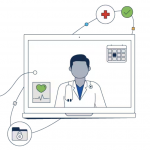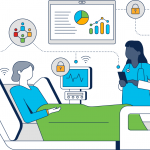In the past, they were called ‘Patients’, today their mindset and their behavior patterns have changed; they are called ‘Consumers’ of healthcare. They just don’t look at healthcare to consume the services when they are sick, but see it as a means to help them maintain their wellness and remain healthy. They want to be in the driver’s seat, and they want to be empowered and be part of the care decisions.
The Health Care Reforms and Health Care Internet of Everything (IoE) have accelerated the adoption of ‘consumer like’ behavior. From its focus on increased access to care and information, prevention and wellness, the meaningful use criteria calls for specific metrics such as the need for at least 5% of patients to send secure messages to providers. These have accelerated the use of patient portals and mobile apps and wellness devices. According to a report by Research and Markets, the mobile health market is expected to reach $26 billion in revenue by 2017.
Earlier this week, I was presenting at a security conference, the SecConX conference 2014 on the subject ‘At the Security Crossroads of Health Care Reforms and IoE enabled e-health’. I started off the presentation with a slide with three questions to gauge the audience’s adoption of consumer grade fitness devices, patient portal and mobile apps.

I was expecting an answer of a total of approximately 50-70% adoption among the audience, but interestingly, the response was about 98% (I will leave out 2% for any majority bias that I might have had or any hands that I failed to see).
My next question was: How many of them were able to do the same 10 years ago, and I did not see one single hand go up.
This to me was telling a transformation was in the making. In the last 10 years, the consumer behavior of the patients have significantly changed for the good to create a more empowered class of consumers who leverage Health care IT innovations to enhance their quality of life, an implicit goal of Health Care Reforms and IoE. While these open new opportunities, it also requires a strong focus on securing these innovations to ensure the benefits for consumers.
In the next parts of this blog, we will look at the key Health Care IT transitions that result from Healthcare reforms and IoE and highlight the security implications they create that we must be aware of.
Stay tuned…


I totally agree with you on this subject. But it should be noted that the mentality of people has changed and also the level of the flow of information.
thank you verymuch the mentality of people has changed and also the level of the flow